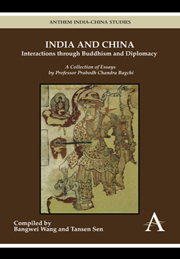 India and China: Interactions through Buddhism and Diplomacy
India and China: Interactions through Buddhism and Diplomacy Book contents
The Visva-Bharati Cheena Bhavana
from Part Two - Short Articles
Published online by Cambridge University Press: 05 March 2012
Summary
It was well known to the great founder of the Visva-Bharati that the history of India could not be properly studied without reference to the history of other Asiatic countries. India in the past gave her civilization to millions of Asiatics. She also did not close her doors to the foreign people, such as the Greeks, the Persians, the Scythians, the Turks and to many others. This great exchange in the past brought about a community of ideas and ideals and established links between various peoples of this continent in spite of their racial and linguistic differences. Tagore wanted to have the past of India studied against this wide canvas when he started his Visva-Bharati.
The first visiting Professor of this new institution was Professor Sylvain Levi, Professor of College de France and a member of the French Academy. He was just the scholar who could inaugurate studies on lines required for the purpose. He started by teaching the Tibetan and Chinese languages and drawing the attention of the Indian scholars to the remains of Indian civilization in Central Asia, Indo-China and Indonesia. It was expected of the students that they would collect materials from all these sources in order to build up slowly the history of the great past of India.
- Type
- Chapter
- Information
- India and China: Interactions through Buddhism and DiplomacyA Collection of Essays by Professor Prabodh Chandra Bagchi, pp. 199 - 202Publisher: Anthem PressPrint publication year: 2011


